Mastering Your Minimalist Color Palette: A Comprehensive Guide to Serene and Stylish Interiors
Minimalist interior design has transcended a mere trend to become a foundational philosophy for creating spaces that are both beautiful and highly functional. Far from being a fleeting fad, minimalism has firmly rooted itself in homes and offices worldwide, offering an escape from the clutter and visual noise of modern life. Yet, a common misconception persists: that minimalism equates to sterile, boring, or impersonal environments. This couldn’t be further from the truth. At its heart, minimalism champions intentionality – every item, every piece of furniture, and indeed, every color, is chosen for its purpose, form, and functionality, contributing to an overall sense of calm and clarity.
This design philosophy is built on the principle of “less is more,” fostering uncluttered spaces that promote tranquility, enhance focus, and exude a timeless modern elegance. While historically, minimalist aesthetics were often synonymous with stark white walls and monochrome palettes, the evolution of this style has gracefully embraced a broader spectrum of hues. Today, integrating color into minimalist design is not only accepted but encouraged, allowing for personalized expressions of warmth, depth, and character without sacrificing simplicity.
Before you dive into exploring myriad minimalist decor ideas, understanding the power of color is paramount. Colors possess an incredible ability to influence our moods, emotions, and overall well-being. A thoughtfully selected color palette can transform a minimalist space from merely functional to genuinely inspiring, creating an atmosphere that resonates with your personal sense of serenity and style. This comprehensive guide will illuminate how to artfully choose the perfect color palette for your minimalist design, ensuring your environment feels both sophisticated and deeply inviting.
Understanding and Selecting Your Minimalist Color Palette
For many, the mention of a minimalist color palette immediately conjures images of stark whites, muted beiges, and subtle greys. While these foundational neutrals are undoubtedly integral to minimalist aesthetics, the contemporary interpretation of this design philosophy offers a much richer and more diverse spectrum. The evolution of minimalist design has moved beyond rigid adherence to monochrome, embracing a sophisticated understanding of how various colors can contribute to an uncluttered yet inviting space. The key is to select hues that exude a profound sense of simplicity, serenity, and balance, rather than overwhelming the senses.
The shift in minimalist color application reflects a broader appreciation for how subtle variations and thoughtful combinations can enhance rather than detract from a minimalist ethos. Modern minimalist color schemes are characterized by their ability to create depth and interest through understated elegance. This involves not just the choice of individual colors, but also how they interact within a space, considering their impact on natural light, the perception of space, and the overall mood. From warm earth tones to cool muted blues, the goal is always to foster an environment of calm and focus. Let’s delve into specific color palettes that masterfully achieve these objectives in minimalist design.
1. The Versatility of Grey
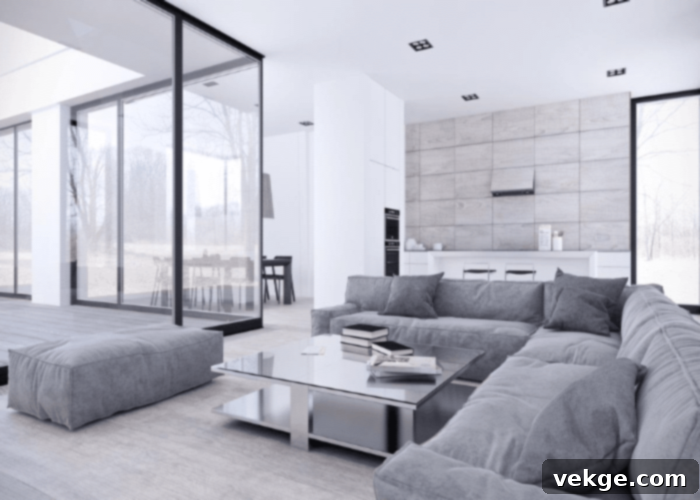
Often mistakenly labeled as drab or uninteresting, grey has emerged as a powerhouse in minimalist interior design, offering a spectrum of shades that range from cool, crisp silvers to deep, warm charcoals. Its understated elegance provides a perfect neutral base, allowing other elements in the room to stand out without competing for attention. Rather than being boring, grey can evoke a sense of calm, sophistication, and even coziness, depending on its undertones and how it’s paired. Utilizing various shades of grey – from light wall paints to darker upholstery or rugs – can create a harmonious, layered look that adds depth and interest to a minimalist space.
In the example image, the thoughtful application of grey beautifully complements the expansive glass windows and pristine white walls, forging a contemporary and inviting atmosphere. Its inherent ability to blend seamlessly with natural light and structural elements makes it an ideal choice for creating serene environments. Grey’s modern appeal is evident in its widespread adoption across various design fields, proving that it is far from dull; it infuses spaces with a refined and enduring vitality.
2. The Warmth of Beige
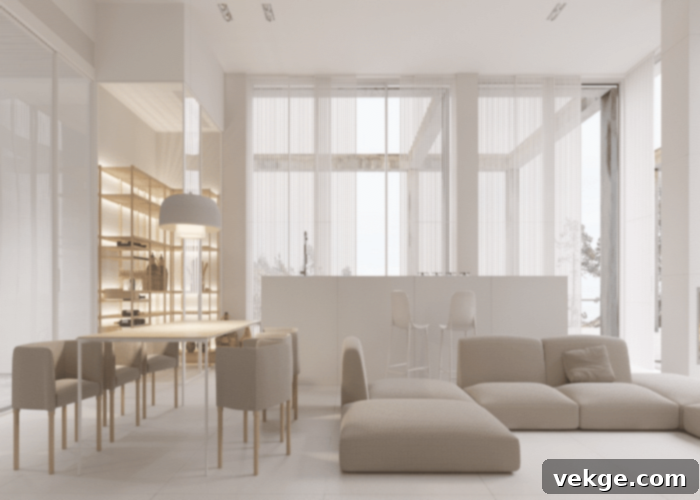
Beige, much like grey, has suffered from misrepresentation, often confined to a single “sandy” shade that might feel uninspired. However, the true breadth of beige encompasses a spectrum from soft, creamy ivories to deeper, almost camel-like tones, each capable of creating distinctly different moods. In minimalist design, beige is a remarkable choice for infusing spaces with a gentle warmth and inviting softness. It acts as a comforting neutral that can make a room feel inherently more grounded and serene, an excellent alternative for those who find cooler greys too stark or modern.
The beauty of beige lies in its subtle depth and organic appeal, making it an ideal backdrop for minimalist interiors. When paired with crisp whites, as elegantly demonstrated in the accompanying image, beige achieves a perfect balance of airiness and comfort, preventing the space from feeling cold. To truly elevate a beige palette, consider incorporating diverse textures—think woven linen, plush wool, or raw wood elements—which add visual interest and tactile richness without introducing clutter. This creates a sophisticated, layered look that celebrates simplicity while offering profound sensory appeal.
3. The Purity and Power of White

White is, perhaps, the quintessential minimalist color, often considered the starting point for any decluttered aesthetic. Its universal appeal stems from its ability to create a sense of expansive space, cleanliness, and quietude. Before dismissing it as too simple or clinical, consider its incredible versatility. White is not a single hue but a spectrum of creams, off-whites, and brilliant snow tones, each reacting differently to light and bringing a unique subtle warmth or coolness to a room. It serves as an immaculate canvas, allowing other design elements—be it furniture, textures, or strategically placed accent colors—to truly shine.
In the accompanying image, the power of white is evident as it beautifully amplifies the vibrant green of the plants, making them pop with refreshing vitality. This illustrates white’s unique capacity to highlight and celebrate natural elements and carefully chosen decor. By reflecting natural light, white can brighten and enlarge even the smallest of rooms, fostering an airy, open, and undeniably serene atmosphere. Its timeless quality ensures that a white-based minimalist design remains fresh, sophisticated, and universally appealing across various design styles and eras.
4. The Timeless Contrast of White and Black
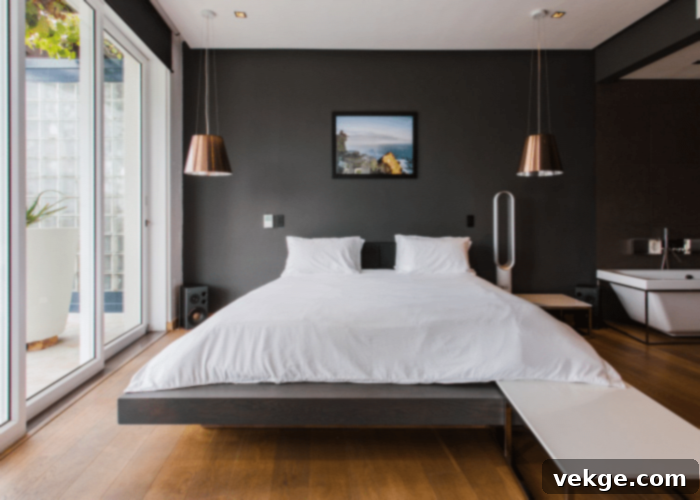
For an unapologetically crisp, sophisticated, and inherently minimalist aesthetic, the classic pairing of white and black remains unparalleled. This dynamic duo offers the highest possible contrast, creating a bold yet balanced visual statement that is both elegant and supremely chic. While seemingly basic, the power of a black and white palette lies in its ability to define space, create strong focal points, and emphasize clean lines – all hallmarks of minimalist design. It’s a combination that speaks volumes through its simplicity, evoking a sense of refined order and timeless style.
The enduring appeal of black and white is evident everywhere, from the elegance of a tuxedo to the strategic layout of a chessboard, or the iconic branding of an Oreo. In interior design, this palette allows for incredible versatility; a predominantly white room can be grounded and given gravitas with black accents, or a darker space can be brightened and opened up with white elements. The key is balance and intentionality. By masterfully playing with these two fundamental hues, you can cultivate a minimalist vibe that is both dramatically striking and perfectly composed, transforming your home into a sanctuary of modern sophistication.
5. The Organic Beauty of Natural Wood Tones
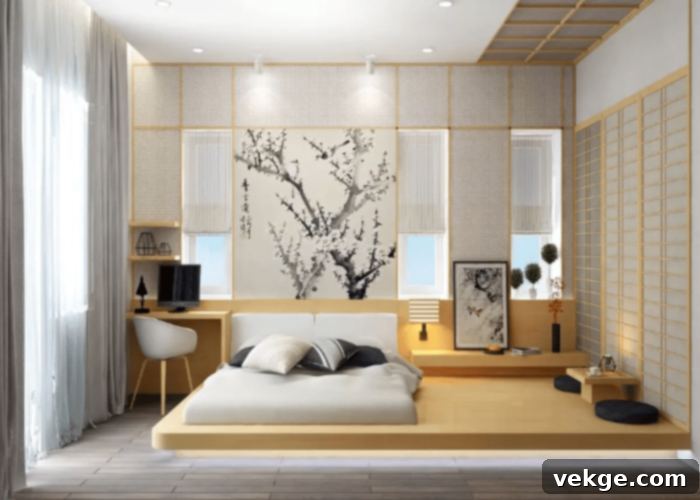
While not a “color” in the traditional sense of paint or fabric, natural wood tones are an indispensable element in many minimalist color palettes, bringing an unparalleled sense of warmth, texture, and organic beauty. The inherent variations in wood grain and stain – from pale, almost white ash to rich, dark walnut – offer a natural spectrum of shades that are both grounding and visually engaging. Incorporating natural wood introduces an element of nature into an indoor space, fostering a tranquil and authentic minimalist atmosphere.
The example image perfectly illustrates this, showcasing a minimalist room with distinct Japanese influences where the interplay of natural wood with crisp black and white elements creates a serene and balanced environment. The tactile quality of wood furniture, flooring, or architectural details adds depth and warmth without requiring additional decorative items. Complementary elements like carefully selected artwork and vibrant green plants further enhance the room’s vitality, ensuring the space feels inviting and alive. Natural wood is a testament to the minimalist principle that beauty lies in simplicity and the inherent quality of materials.
6. Earthy Elegance with Brown

For those seeking to imbue their minimalist spaces with profound warmth and a connection to the natural world, brown, and its broader family of earthy tones, presents an exquisite choice. Moving beyond the starkness of black and white, shades like chocolate, tan, terracotta, and even muted rusts offer a rich, inviting alternative. These colors evoke a sense of grounding and comfort, creating an instantly welcoming environment without sacrificing the clean lines and uncluttered feel characteristic of minimalist design.
The featured image beautifully demonstrates how different shades of brown can harmonize within a space, with the sofa, floor, and wall working in seamless concert. This monochromatic approach to earthy tones creates a cohesive and deeply tranquil atmosphere. To amplify the minimalist appeal and sensory richness, consider layering various textures: a smooth leather sofa, a coarse woven rug, and perhaps a subtly textured wall finish. Brown’s versatility allows it to pair exceptionally well with crisp whites, natural greens, and even muted blues, making it a cornerstone for a minimalist aesthetic that prioritizes warmth, organic beauty, and sophisticated simplicity.
7. The Subtle Sophistication of Taupe
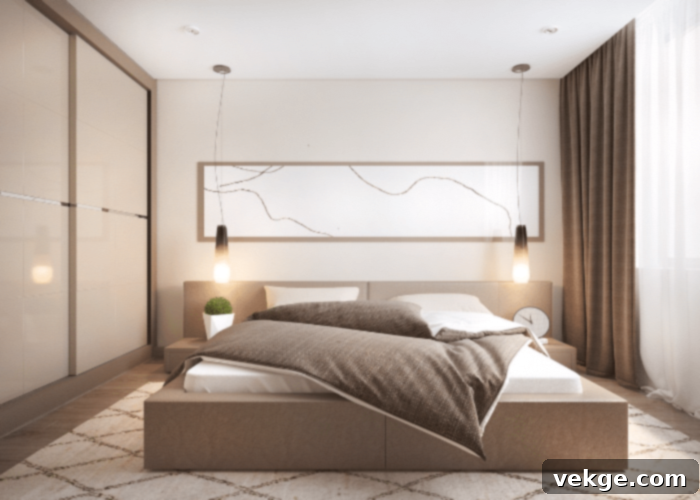
Taupe, a nuanced blend of grey and brown, stands out as a wonderfully sophisticated and versatile choice for minimalist decor, offering a richer alternative to pure grey and a cooler edge than traditional beige. Its unique character lies in its ability to embody both warmth and modernity simultaneously, making it exceptionally adaptable to a variety of lighting conditions and accompanying color schemes. Taupe is particularly adept at creating an atmosphere of understated luxury and calm, perfect for bedrooms, living rooms, and even home offices where tranquility is paramount.
As illustrated in the example image, the combination of taupe with crisp white creates an exceptionally cozy and inviting bedroom setting. The warmth inherent in taupe prevents the white from appearing too stark or cold, instead fostering a soft, harmonious balance that promotes relaxation. Whether applied to walls, furniture upholstery, or textiles, taupe lends an organic, earthy elegance that aligns perfectly with the minimalist ethos of simplicity and intentional design. Its subtle depth allows for a layered look without visual clutter, making it a top choice for those seeking refined, serene interiors.
8. Introducing Zest with Yellow Accents

The evolution of minimalist design beautifully demonstrates that a love for bold and bright colors does not necessitate abandoning a decluttered aesthetic. Indeed, vibrant hues like yellow can be masterfully incorporated to inject personality and an uplifting spirit into a minimalist space, provided they are used intentionally and with balance. Yellow, a color associated with happiness, energy, and optimism, serves as an exquisite accent, creating focal points that enliven a room without compromising its serene foundation.
The key to integrating a bright color like yellow into minimalist design lies in pairing it thoughtfully with predominant neutral tones. In the example image, the striking yellow wall and chair are softened and balanced by the surrounding white table and artwork. This strategic use of neutrals ensures that the yellow acts as a vibrant accent, drawing the eye and adding character, rather than overwhelming the space. It proves that you don’t have to choose between a minimalist environment and a colorful one; you can elegantly achieve both, creating a home that is both calming and creatively expressive. This approach transforms a space from merely simple to thoughtfully stimulating.
Beyond the Palette: Tips for Harmonious Minimalist Color Integration
Choosing the right colors is just the first step in creating a truly exceptional minimalist interior. The way these colors are implemented, balanced, and complemented by other elements is equally crucial. To ensure your chosen color palette translates into a serene and stylish reality, consider these additional tips:
Layering Textures for Depth
Minimalism thrives on tactile interest, especially when working with limited colors. Instead of relying on numerous objects, use a variety of textures in your chosen hues. Think about a cashmere throw on a linen sofa, a matte ceramic vase on a polished wooden table, or a textured wallpaper against smooth painted walls. These layers add visual and sensory depth, making monochromatic or neutral spaces feel rich and inviting, rather than flat or uninspired. It’s about letting the materials speak for themselves.
Embracing Natural Light
Natural light is arguably the most powerful element in a minimalist space, and it profoundly interacts with your chosen colors. Lighter colors will reflect more light, making a room feel larger and brighter, while darker shades will absorb it, creating a more intimate and grounded atmosphere. Observe how light changes throughout the day in your space and how it affects your palette. Sheer curtains or unobstructed windows are minimalist staples that maximize light, allowing colors to truly come alive and showcase their subtle nuances.
Strategic Use of Accent Colors
While a predominantly neutral palette defines much of minimalist design, strategically introduced accent colors can elevate a space from simple to sophisticated. As seen with yellow, a single piece of art, a vibrant throw pillow, a small plant, or a carefully chosen chair can provide a pop of color that draws the eye and adds personality. The key is restraint: choose one or two accent colors and use them sparingly to maintain the uncluttered aesthetic. This creates visual interest without introducing chaos, reinforcing the “less is more” principle.
Considering the Flow Between Rooms
When designing an entire home, think about how your color palettes transition from one room to another. A cohesive flow creates a sense of harmony and expands the perception of space. You don’t need identical colors, but rather a consistent underlying theme or a gradual shift in shades. For instance, moving from a warm beige living room to a cooler grey bedroom can be harmonious if both rooms share a unifying element, like natural wood accents or a consistent approach to lighting. This thoughtful continuity enhances the overall tranquil experience of your home.
Final Thoughts on Cultivating Your Minimalist Sanctuary
Minimalism transcends mere aesthetic; it is a profound design philosophy that extends an invitation to declutter not just your spaces but your mind, much like the principles championed by Marie Kondo. The enduring mantra of “less is more” perfectly articulates the essence of minimalist design, which is characterized by clean lines, essential simplicity, and unwavering purpose. Every element within a minimalist interior – from a carefully selected piece of furniture to the chosen wall color – is deliberate, serving both a functional and an aesthetic role, which is precisely why this design style continues to captivate and inspire so many.
For those who harbor a deep appreciation for color, the journey into minimalist design should not be viewed as a sacrifice, but rather an exciting opportunity for thoughtful expression. This comprehensive guide has illuminated the myriad ways to integrate rich, calming, or even vibrant hues into a minimalist setting, moving beyond outdated notions of sterile environments. You are now equipped with the knowledge to select a color palette that not only aligns with minimalist principles but also resonates deeply with your personal style and emotional well-being.
Armed with these insights into grey’s sophistication, beige’s warmth, white’s purity, the drama of black and white, the organic touch of natural wood, the grounding nature of brown, the subtle elegance of taupe, and the playful zest of yellow accents, you are now fully prepared to transform your house or office. Embrace the power of intentional color to create a space that is not only visually stunning and uncluttered but also deeply personal, tranquil, and conducive to a focused, serene lifestyle. We invite you to share your experiences in the comments below: Which minimalist color palette did you choose? What was your inspiration? How have you implemented it in your space, and what insights can you offer to others embarking on their minimalist decor journey?
